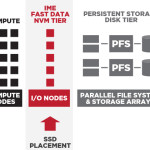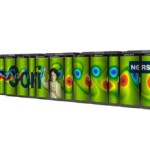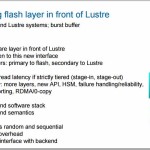A new paper outlining NERSC’s Burst Buffer Early User Program and the center’s pioneering efforts in recent months to test drive the technology using real science applications on Cori Phase 1 has won the Best Paper award at this year’s Cray User Group (CUG) meeting.
Storage Performance Modeling for Future Systems
In this video from the 2016 MSST Conference, Yoonho Park from IBM presents: Storage Performance Modeling for Future Systems. “The burst buffer is an intermediate, high-speed layer of storage that is positioned between the application and the parallel file system (PFS), absorbing the bulk data produced by the application at a rate a hundred times higher than the PFS, while seamlessly draining the data to the PFS in the background.”
CSCS to Double Performance of Cray Supercomputer with GPUs
Europe’s most powerful supercomputer Piz Daint is being upgraded, a move that is expected to at least double its computing power. ETH Zurich is investing around CHF 40 million to allow researchers to perform simulations, data analyses and visualizations even more efficiently in the future. Although slightly reduced in physical size, Piz Daint will become considerably more powerful as a result of the upgrade, particularly because we will be able to significantly increase bandwidth in the most important areas,” says CSCS Director Thomas Schulthess.
Gary Grider Presents: HPC Storage and IO Trends and Workflows
“Trends in computer memory/storage technology are in flux perhaps more so now than in the last two decades. Economic analysis of HPC storage hierarchies has led to new tiers of storage being added to the next fleet of supercomputers including Burst Buffers or In-System Solid State Storage and Campaign Storage. This talk will cover the background that brought us these new storage tiers and postulate what the economic crystal ball looks like for the coming decade. Further it will suggest methods of leveraging HPC workflow studies to inform the continued evolution of the HPC storage hierarchy.”
Video: Meet IME – The World’s First Burst Buffer
“DDN’s IME14K revolutionizes how information is saved and accessed by compute. IME software allows data to reside next to compute in a very fast, shared pool of non-volatile memory (NVM). This new data adjacency significantly reduces latency by allowing IME software’s revolutionary, fast data communication layer to pass data without the file locking contention inherent in today’s parallel file systems.”
Five Supercomputing Predictions from Cray’s Barry Bolding
“There are a number of exciting technologies we should see in 2016, and a leader will be Intel’s next-generation Xeon Phi coprocessor – a hybrid between an accelerator and general purpose processor. This new class of processors will have a large impact on the industry with its innovative design that combines a many-core architecture with general-purpose productivity. Cray, for example, will be delivering Intel Xeon Phi processors with some of our largest systems, including those going to Los Alamos National Labs (the “Trinity” supercomputer) and NERSC (the “Cori” supercomputer).”
Video: DDN Infinite Memory Engine IME
Tommaso Cecchi from DDN presented this talk at the HPCAC Spain Conference. “IME unleashes a new I/O provisioning paradigm. This breakthrough, software defined storage application introduces a whole new new tier of transparent, extendable, non-volatile memory (NVM), that provides game-changing latency reduction and greater bandwidth and IOPS performance for the next generation of performance hungry scientific, analytic and big data applications – all while offering significantly greater economic and operational efficiency than today’s traditional disk-based and all flash array storage approaches that are currently used to scale performance.”
Video: Infinite Memory Engine (IME) Burst Buffer Experience at CSCS
Hussein Harake from CSCS presented this talk at the HPC Advisory Council Spain Conference. “IME unleashes a new I/O provisioning paradigm. This breakthrough, software defined storage application introduces a whole new new tier of transparent, extendable, non-volatile memory (NVM), that provides game-changing latency reduction and greater bandwidth and IOPS performance for the next generation of performance hungry scientific, analytic and big data applications – all while offering significantly greater economic and operational efficiency than today’s traditional disk-based and all flash array storage approaches that are currently used to scale performance.”
Users to Test DataWarp Burst Buffer on Cori Supercomputer
NERSC has selected a number of HPC research projects to participate in the center’s new Burst Buffer Early User Program, where they will be able to test and run their codes using the new Burst Buffer feature on the center’s newest supercomputer, Cori.
Video: On the Role of Flash in Large-Scale Storage Systems
Nathan Rutman from Seagate presented this talk at the LAD’15 Conference. “So why is a spinning disk company talking about Flash? Last year, Seagate acquired Avago LSI’s flash division. We now have an array of flash-based storage. So I have nothing against Flash. This presentation is really on: Where does Flash make sense? I also have a personal agenda because I hate the term “Burst Buffer.” Everyone says “Burst Buffer” instead of saying “Flash.” It drives me crazy. So I’m going to explain what a Burst Buffer is and what it is not.”












